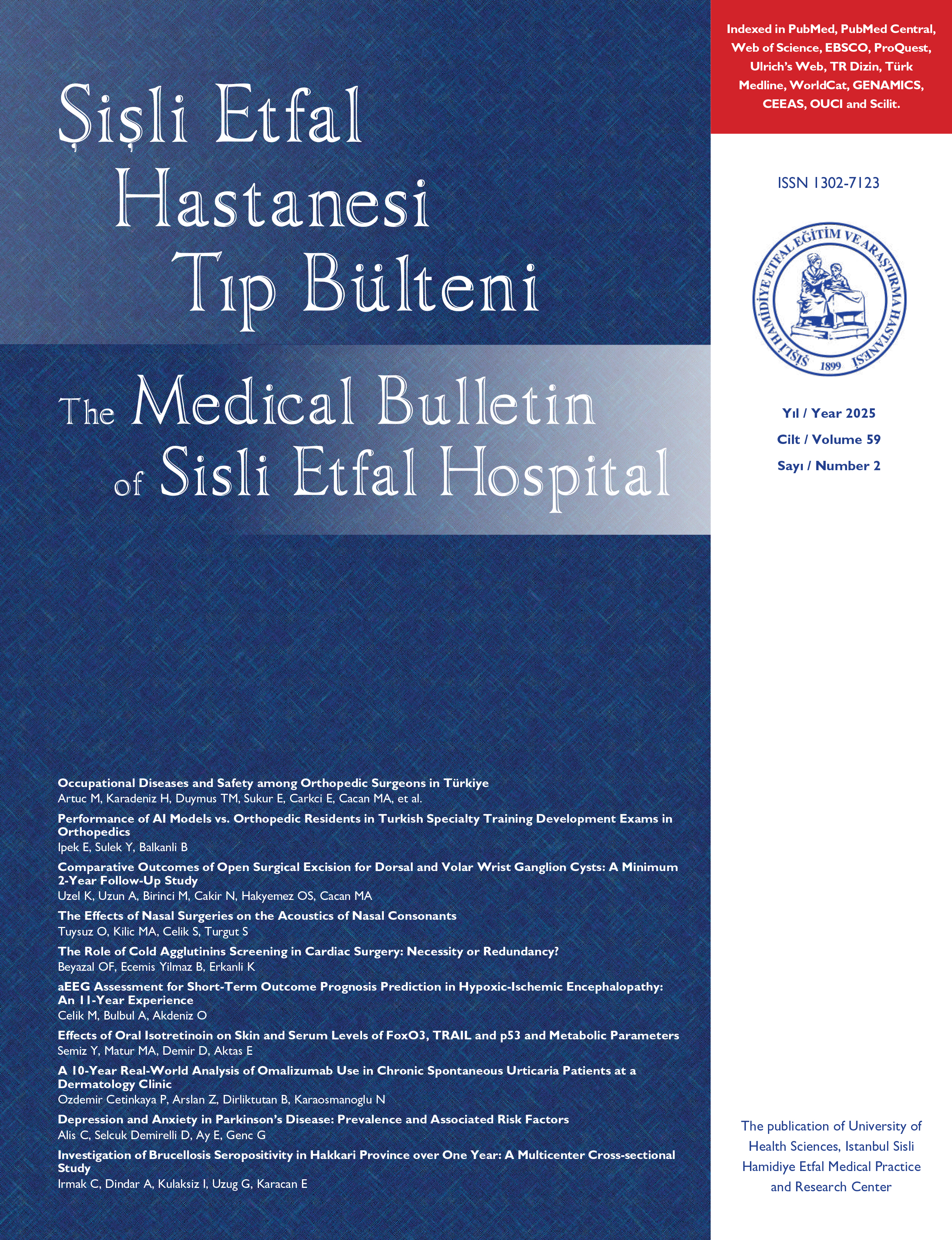
The Effects of Smoking in Patients in the Intensive Care Unit During the COVID-19 Pandemic
Seyhan Metin1, Nermin Balta Basi1, Sultan Acar Sevinc1, Aysel Salkaya1, Nurcan Coskun1, Leyla Kilinc Turkoglu1, Ayse Surhan Cinar1, Sibel Oba1, Haci Mustafa Ozdemir21Department of Anesthesiology and Reanimation, University of Health Sciences Türkiye, Sisli Hamidiye Etfal Training and Research Hospital, Istanbul, Türkiye2Department of Orthopedics, University of Health Sciences Türkiye, Sisli Hamidiye Etfal Training and Research Hospital, Istanbul, Türkiye
Objectives: In this study, we aimed to see the effects of smoking prevalence, the length of stay regarding the usage of cigarettes, and the effects on the mortality of COVID-19 in our Intensive Care Unit (ICU).
Methods: This is a retrospective single-centered study that was done in the ICU on patients with COVID-19 between 16th of March and 16th of May in 2020. The demographic data, comorbidity status, the units they were accepted from, clinical symptoms, respiratory support, prevalence of smoking, length of stay in the ICU, and mortalities of the patients were recorded. There were two groups: Smoker and non-smoker. There were 1100 COVID-19 patients and 150 of these were treated in ICU unit. 95 patients data were accessed. Statistical analyses were performed with the Scientific Package for the Social Science (version 21.0; SPSS Inc.). Results: There were 69.4% non-smoker and 35.8% smoker, and 5.3% of the smoker did smoke before (Table 1). The average age of the patients in smoker group was less than nonsmoker. The incidence of chronic obstructive pulmonary disease was higher in smokers (Table 2). The most common symptom was cough and it was 82% in nonsmoker group and 76.5% in smoker group (Table 3). In both groups, respiratory support was provided by İMV (Table 4). There was no relationship between two groups according to age (p=0.044) and gender of patients (p: 0.062) (Table 2). The length of ICU stay was 7.6 days for smoking patients in the ICU and 9.3 days for non-users. While the mortality was 52.9% for smokers, it was 39.3% for non-smokers. No statistical correlation was found between smoking status, length of stay in ICU, and survival (Fig. 1). Smoking is blamed among the factors that cause this aggressive process, which can progress to respiratory failure and result in mortality in COVID-19 disease.
Conclusion: Some studies also claim that smoking can be protective. There is still no clarity on this issue. It was concluded that smoking has no effect on the duration of ICU stay and mortality in patients treated in the ICU with respiratory failure due to COVID-19 pneumonia.
COVID-19 Pandemisi Sırasında Yoğun Bakım Ünitesindeki Hastalarda Sigara İçmenin Etkileri
Seyhan Metin1, Nermin Balta Basi1, Sultan Acar Sevinc1, Aysel Salkaya1, Nurcan Coskun1, Leyla Kilinc Turkoglu1, Ayse Surhan Cinar1, Sibel Oba1, Haci Mustafa Ozdemir21Türkiye Sağlık Bilimleri Üniversitesi, Şişli Hamidiye Etfal Eğitim ve Araştırma Hastanesi, Anesteziyoloji ve Reanimasyon Kliniği, İstanbul2Türkiye Sağlık Bilimleri Üniversitesi, Şişli Hamidiye Etfal Eğitim ve Araştırma Hastanesi, Ortapedi Kliniği, İstanbul
Amaç: Bu çalışmada Yoğun Bakım Ünitemizde (YBÜ) sigara içme prevalansının, sigara kullanımına bağlı kalış süresinin ve COVID-19 mortalitesi üzerine etkilerini görmeyi amaçladık.
Gereç ve Yöntem: 16 Mart-16 Mayıs 2020 tarihleri arasında COVID-19 hastaları üzerinde yoğun bakım ünitesinde yapılan retrospektif tek merkezli bir çalışmadır. Demografik veriler, komorbidite durumları, kabul edildikleri birimler, klinik semptomlar, solunum desteği, hastaların sigara içme sıklığı/prevalansı, yoğun bakımda kalış süreleri ve mortaliteleri kaydedildi. Hastalar sigara içen ve içmeyen olarak iki gruba ayrıldı. 1100 COVID-19 hastası vardı ve bunlardan 150'si yoğun bakım ünitesinde tedavi gördü. 95 hastanın verilerine ulaşıldı. İstatistiksel analizler Sosyal Bilimler için Bilimsel Paket ile yapıldı.
Bulgular: Hiç sigara içmemiş hastalar %64.2'di. Bu hastaların %5.3'ü daha önce sigara içen, %30,5'i ise aktif içici idi. Sigara içen gruptaki hastaların yaş ortalamasının içmeyenlere göre daha az olduğu görüldü. Sigara içenlerde kronik obstrüktif akciğer hastalığı insidansı daha yüksek bulundu. Sigara içme durumu, yoğun bakımda kalış süresi ve sağkalım arasında ilişki bulunamadı. Sigara kullanımı, COVID-19 hastalığında solunum yetmezliğine kadar ilerleyebilen ve ölümle sonuçlanabilen agresif sürece neden olan faktörler arasında yer almaktadır.
Sonuç: Bazı araştırmalar da sigaranın koruyucu olabileceğini iddia etmektedir. Bu konu hakkında henüz bir netlik yoktur. COVID-19 pnömonisine bağlı solunum yetmezliği olan YBÜ'de tedavi edilen hastalarda sigara içmenin yoğun bakımda kalış süresi ve mortalite üzerinde etkisi olmadığını ortaya koydu. (SETB-2023-01-012)
Manuscript Language: English



















